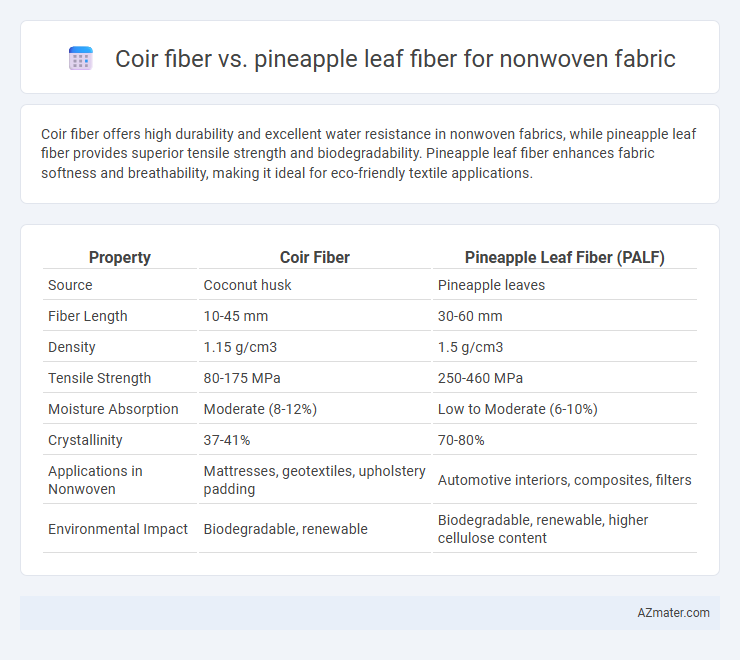Coir fiber offers high durability and excellent water resistance in nonwoven fabrics, while pineapple leaf fiber provides superior tensile strength and biodegradability. Pineapple leaf fiber enhances fabric softness and breathability, making it ideal for eco-friendly textile applications.
Table of Comparison
| Property | Coir Fiber | Pineapple Leaf Fiber (PALF) |
|---|---|---|
| Source | Coconut husk | Pineapple leaves |
| Fiber Length | 10-45 mm | 30-60 mm |
| Density | 1.15 g/cm3 | 1.5 g/cm3 |
| Tensile Strength | 80-175 MPa | 250-460 MPa |
| Moisture Absorption | Moderate (8-12%) | Low to Moderate (6-10%) |
| Crystallinity | 37-41% | 70-80% |
| Applications in Nonwoven | Mattresses, geotextiles, upholstery padding | Automotive interiors, composites, filters |
| Environmental Impact | Biodegradable, renewable | Biodegradable, renewable, higher cellulose content |
Introduction to Natural Fibers in Nonwoven Fabrics
Coir fiber and pineapple leaf fiber are prominent natural fibers used in nonwoven fabric production due to their sustainability and biodegradability. Coir fiber, derived from coconut husks, offers high abrasion resistance and coarse texture ideal for geotextiles and erosion control, whereas pineapple leaf fiber provides finer, stronger fibers suited for upholstery and automotive applications. The integration of these fibers enhances the ecological profile of nonwoven fabrics while maintaining necessary mechanical properties for diverse industrial uses.
Overview of Coir Fiber: Properties and Sources
Coir fiber, derived from the outer husk of coconut shells, is characterized by its coarse texture, high tensile strength, and excellent water resistance, making it suitable for durable nonwoven fabric applications. Predominantly sourced from countries like India, Sri Lanka, and the Philippines, coir fiber is abundant as a natural byproduct of the coconut industry, promoting sustainability. Its lignin content lends rigidity and resilience, distinguishing it from softer fibers like pineapple leaf fiber in nonwoven textile manufacturing.
Pineapple Leaf Fiber: Characteristics and Extraction
Pineapple leaf fiber, known for its high tensile strength and excellent moisture absorption, offers superior durability and flexibility compared to coir fiber in nonwoven fabric applications. Extracted through a decortication process, the fibers are separated from pineapple leaves, cleaned, and spun into fine threads, ensuring a smooth texture ideal for textile manufacturing. Its natural lignin content enhances biodegradability, making pineapple leaf fiber an eco-friendly alternative with promising mechanical properties for sustainable nonwoven fabrics.
Mechanical Strength Comparison
Coir fiber exhibits superior tensile strength and abrasion resistance compared to pineapple leaf fiber, making it highly durable for heavy-duty nonwoven fabrics. Pineapple leaf fiber, while lighter and more flexible, offers moderate mechanical strength suitable for applications requiring softer texture and moderate durability. The higher lignin content in coir fiber contributes to its enhanced mechanical strength, whereas the cellulose-rich pineapple leaf fiber provides better flexibility but lower overall stress tolerance.
Moisture Absorption and Water Resistance
Coir fiber exhibits low moisture absorption and high water resistance due to its dense lignin content, making it ideal for nonwoven fabric applications requiring durability in wet conditions. Pineapple leaf fiber (PALF) demonstrates higher moisture absorption owing to its cellulose-rich structure but offers moderate water resistance when treated or blended. These distinct moisture properties influence the suitability of coir and pineapple leaf fibers in specific nonwoven fabric products such as mats, geotextiles, and composites.
Environmental Impact and Sustainability
Coir fiber exhibits high biodegradability and is sourced from coconut husks, making it a renewable resource with minimal environmental footprint in nonwoven fabric production. Pineapple leaf fiber, derived from agricultural waste, offers exceptional sustainability benefits by promoting waste valorization and reducing resource depletion compared to conventional fibers. Both fibers contribute to eco-friendly textiles, but pineapple leaf fiber's use of agro-residue provides greater potential for circular economy integration in sustainable nonwoven fabric manufacturing.
Cost-Effectiveness and Economic Factors
Coir fiber offers a cost-effective raw material for nonwoven fabric production due to its abundant availability and low processing costs, making it attractive for large-scale, budget-sensitive applications. Pineapple leaf fiber, though generally more expensive to source and process, provides superior mechanical strength and durability that can justify higher initial investments in products requiring enhanced performance. Economic decisions between coir and pineapple leaf fibers must consider supply chain stability, local labor costs, and end-use market demand to optimize overall cost-effectiveness in nonwoven fabric manufacturing.
Applications in Nonwoven Fabrics
Coir fiber and pineapple leaf fiber both serve as sustainable reinforcements in nonwoven fabrics, with coir's coarse texture providing excellent durability for automotive upholstery, mats, and geotextiles. Pineapple leaf fiber, recognized for its fine, strong, and lightweight characteristics, is ideal for producing eco-friendly nonwoven textiles used in filtration, medical supplies, and composite materials. The choice between coir and pineapple leaf fiber depends on the required tensile strength, flexibility, and biodegradability needed in applications such as sound insulation, packaging, and agricultural nonwovens.
Processing Challenges and Solutions
Coir fiber, derived from coconut husks, presents challenges such as high lignin content and coarse texture that complicate fiber extraction and uniform web formation in nonwoven fabric production; chemical retting and mechanical decortication improve fiber softness and yield. Pineapple leaf fiber offers finer, more flexible strands but suffers from variability in fiber length and moisture content, demanding controlled drying and fiber blending technologies to ensure consistent web integrity. Advances in enzymatic treatments and hybrid fiber matting methods address these processing hurdles, enhancing compatibility with nonwoven production equipment and improving fabric quality.
Future Prospects and Innovations
Coir fiber and pineapple leaf fiber exhibit significant potential in nonwoven fabric applications due to their biodegradability and mechanical strength. Innovations in enzyme treatments and nanofiber blending techniques enhance their durability, flexibility, and moisture resistance, expanding their use in medical textiles and eco-friendly packaging. Future prospects include integrating these fibers with advanced polymer composites to create sustainable and high-performance nonwoven materials, meeting increasing demands for green alternatives in the textile industry.

Infographic: Coir fiber vs Pineapple leaf fiber for Nonwoven Fabric
 azmater.com
azmater.com